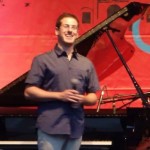Yamaha 32 (vintage) Part III: Pianica P-32B
Tagged: P-34B?, Yamaha Pianica P-32B
- This topic has 9 replies, 4 voices, and was last updated 2 years, 8 months ago by
 Gerald de Peralta.
Gerald de Peralta.
-
AuthorPosts
-
April 19, 2015 at 11:06 pm #4745
 Alan BrintonParticipant
Alan BrintonParticipantThe P-32B is the Edsel of Yamaha Pianicas, an evolutionary dead end in the otherwise orderly progression from the original Pianica 32 to the modern day P-32D. I was excited to get my hands on one but was immediately unenthusiastic about its un-Yamaha sound and its leakiness. Since I disassembled, cleaned, and screwed it back together, it is so leaky (for no visible reason) that it barely plays. The reeds are mounted on the inside of the reed air chamber, as with the P-32, and the reeds and plates look the same, except that they were seriously discolored, with some corrosion. The P-32B was made from 1973-1978. Every other Yamaha Pianica I have seen from the 1970s has “Made in Japan” or “Japan” on the Pianica itself or on the case. The P-32B does not, and it is so unlike any other Yamaha Pianica that there is reason to wonder if the manufacture and even the design of this particular model was farmed out to another country. For some time, Yamaha Pianicas were designed and manufactured by the Tokai Gakki Company, and it is possible that Yamaha was experimenting with another manufacturer. Eventually, Yamaha shifted production from Japan to Indonesia, where present day Yamaha Pianicas are made, but without design changes or compromises in quality. Here are photos I took today of the P-32B:





Comparison of P-32B reeds (top) with modern P-32D reeds (bottom)

P-32B reed plates before and after cleaning. I used a toothbrush with baking soda and rubbing alcohol, and then resorted to toothpaste.
The workmanship is not up to par with other Yamaha Pianicas, which can perhaps be seen in this photo, for example in how the end of the mouthpiece receptacle is fused in the middle.
The blue disk separates from the disk beneath it when the spit button is depressed.

Protruding from the casing at the bottom are the ends of the key springs, which are not otherwise visible or accessible without further disassembly (how this would be done was unclear to me, maybe with a chisel and mallet).Is it possible that this is not really a Yamaha at all, but a counterfeit? For two reasons I don’t think so. One is that it was sold on a Japanese auction site, most of whose customers are familiar with Yamaha Pianicas because of their use in childhood education in Japan; the other is that Yamaha did sell a Model P-32B (whose dates I indicated above). On the other hand, the composition of the reeds must not be the same, even though they seem to be otherwise made to the same specifications. I haven’t seen any other Yamaha reeds in this kind of condition.
April 19, 2015 at 11:11 pm #4746 Alan BrintonParticipant
Alan BrintonParticipantFor anyone who wants one, I’d be willing to part with this rare penguinesque beauty for a bargain price.
April 20, 2015 at 6:16 am #4749 OfirParticipant
OfirParticipantThank you Alan!
Two thoughts that I had while reading:
1. I read more than once in the group about a hard-to-find leakage. As the melodica should be water resistive (I even remember one dishwashed his), why not trying to spot a leakage inside a bowl of water, just like you would do looking for a puncture?2. If I wouldn’t posted my video, would the word “penguinesque” find itself spontaneously in this forum? 😉
April 20, 2015 at 9:44 am #4753 Alan BrintonParticipant
Alan BrintonParticipant1. I’ll try that, Ofir. I’m pretty sure the problem arises in one of two places or both: the fused part of the mouthpiece receptacle and/or some breaks in the main seal (seal?). But I think it’s probably not worth fixing unless I can find a willing P-32 donor with matching reeds for a reed transplant.
2. Probably not. We take our inspiration from where we can find it.
April 20, 2015 at 9:41 pm #4767 Alan BrintonParticipantJuly 17, 2021 at 2:09 am #13725
Alan BrintonParticipantJuly 17, 2021 at 2:09 am #13725 Gerald de PeraltaParticipant
Gerald de PeraltaParticipantI see that this thread is already six years old. Well, I just got a used one from an online vendor. I immediately disassembled it for sanitation purposes, and it’s a PAIN to reassemble. The leaks could probably due to the seals–they are no longer supple enough to be airtight, hence the “leakiness.” Unless you have fresh gaskets for this thing, DO NOT remove the cartridge.
Looks like the last resort will be to use caulk.Or will automotive gasket work? Who knows.
July 17, 2021 at 1:20 pm #13726 Alan BrintonParticipant
Alan BrintonParticipantHi, Gerald. Quite a lot has been posted here about replacing gaskets. It’s not hard to fashion a newmain gasket.You can find info on this by searching the forums. Caulking would be a last resort.
July 19, 2021 at 12:10 pm #13727 DarenKeymaster
DarenKeymasterI use weather strip – find a thickness that matches the seal you’re replacing, and trim the width to size
Link: https://amzn.to/3ivHRbQ
July 19, 2021 at 1:46 pm #13730 Alan BrintonParticipant
Alan BrintonParticipantLook also for “foam seal tape”, 1/16 or 1/8 inch thick. You want something that sticks (“self-sealing”) but doesn’t glue or have to be glued down. Weather strip, as Daren suggests, does that, though it’s a more general class of tape. It’s relatively cheap and you get a roll, so there’s plenty of room for experimentation and repeated attempts. It also should be soft and flexible enough to compress somewhat when you screw the cover back down. Also, you’ll cut it into strips whose ends compress when you put them in place.
August 6, 2021 at 2:55 am #13756 Gerald de PeraltaParticipant
Gerald de PeraltaParticipantI’ve already put an order for a roll. I think this will also solve the leakiness in my Suzuki S-32.
-
AuthorPosts
- You must be logged in to reply to this topic.



